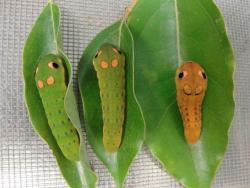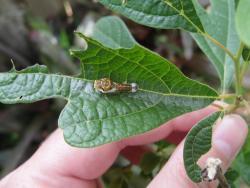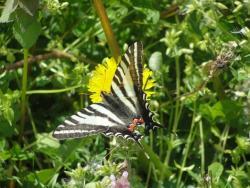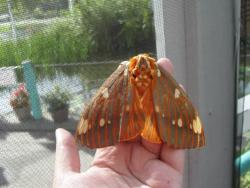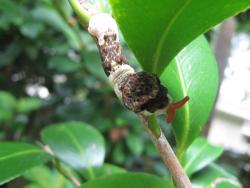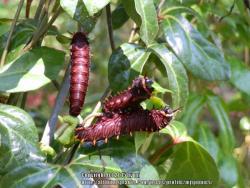Since we're talking pipevine and I am now fully awake (with a Stabucks Iced Vanilla Latte for help), it's time for Melanie's Pipevine PSA or "How to Stop Worrying and Love the Caterpillars."
Pipevines can be a tricky thing in Florida (and probably Texas, too). You see, we are blessed with two kinds of Swallowtails that eat Pipevine, or Aristolochia species. Aristolochia plants have a chemical aptly called aristolochic acids, which makes the caterpillars most distasteful. In a story I can't make up, there is a professor I read about who has eaten one of every kind of caterpillar he has raised to see how bad they really taste. He deemed the Pipevine Swallowtail the worst, but he wasn't in a region where Polydamas lived which made me wonder if he had a thorough sample. Not that I advocate eating caterpillars.
The Pipevine Swallowtail is pretty much a North American butterfly and is found through pretty much all of Florida. The Polydamas, on the other hand, is more of a tropical butterfly found in Central and South America, as well as many islands in the Caribbean. Many islands even have their own subspecies due to the isolated nature of their populations. According to my field guide, the Polydamas doesn't go up much into the Panhandle, but my book is also wrong a lot. So for the most part, the Pipevine and the Polydamas have their own territories. Except for us lucky few where they overlap. And that's where the problems begin.
Before humans came along and messed everything up, the butterflies happily used the pipevines that were native to their area. The Pipevine Swallowtail mostly uses a plant called Virginia Snakeroot (A.serpentaria). I wouldn't know this plant if it slapped me in the face. From what I know, it mostly grows along the ground and the caterpillars actually need many plants to grow to adulthood because it doesn't get very large. From the shape of the leaves, I would probably assume it was skunkvine and pull it up. But, there are other native Aristolochias such as the one I've been growing, Wooly Pipevine or A. tomentosa. According to the ISB Plant Atlas (
http://www.florida.plantatlas....) it's only native to the panhandle but I have had no problem growing it here. For some odd reason I haven't added any photos to the plant database, but other folks have. I will rectify that soon. There is also a native A. pentandra which grows only in two counties in south Florida. Both A. tomentosa and A. pentandra are listed as endangered which I think is another reason to grow them.
Now, there are other pipevines, too. Most of the ones you see for sale are going to be the tropical pipevines with the huge crazy flowers. Usually called Dutchman's Pipevine or Calico Flower, these include species like A. elegans, A. macrophylla, A. grandiflora, and A. gigantea. These plants are mostly native to Central and South America so they're fine for the Polydamas who evolved right along with them. However, the Pipevine Swallowtails will use them, too only to die in the vast majority of cases (okay, all the cases I've seen). I have a theory that the tropical species have more Aristolochic acids than the North American ones and that the Pipevine Swallowtail caterpillars are not able to harbor as much of the chemical as the Polydamas Swallowtail. That's just my theory. If anyone wants to give me a lab, some assistants, and a research grant, I will get right on it. FYI, there's an A. littoralis (common name Elegant Dutchman's Pipevine or Calico Flower) that is a Category II invasive in Florida.
Then, there are pipevines that sort of fall in the middle. MJ listed two of them for us: A. fimbriata and A. trilobata. I've also seen A. triloba and can't figure out if it's different than A. trilobata or a synonym. Some people claim these are okay for both species. We actually have both at MOSI (although we just got the A. fimbriata last year) and I have to say that I think the verdict is out. I have seen Pipevine Swallowtails make it to adulthood on A. trilobata, but we've never been able to raise Pipevines Swallowtails with the same success as the other Swallowtail species. This may just be natural, but I can't help but wonder. I've only had my Wooly Pipevine for about two years and haven't been able to raise enough caterpillars to form an opinion on their "normal" survival rate.
So now you might be thinking, "Why would people plant the tropical varieties?" Well, many reasons. Some aren't butterfly gardeners and just like the crazy flowers. Availability is a huge reason. But a big reason is that the tropical varieties grow much larger and much faster than the natives. I bought a Dutchman's Pipevine simply to have enough food to keep up with the demand from the Polydamas. In doing so, I knew I had to take the responsibility to check that vine at least every other day and remove any Pipevine Swallowtail eggs so I wouldn't kill them. But not everybody does that or knows to do that. I have since ripped out the Dutchman's Pipevine and I am going strictly native this year. (I also ripped out all my Tropical Milkweed but that's another post.) I only have two Wooly Pipevine plants which are just leafing out but I am going to purchase more. A lot more. And then I'm going to grow some in my shade house (where the orchids hang out) so the butterflies can't lay eggs on them.
And now you may be thinking, "Melanie, how do I know which ones I've got?" Fortunately, the eggs are super easy to tell apart. Pipevine ST eggs are reddish-orange while Polydamas eggs are generally golden yellow (although sometimes they verge on a greenish-yellow. Now, my book (and conventional butterfly wisdom) will tell you that a butterfly will not lay eggs on a plant that already has eggs on it. And to that I say, "Bunk!" While most Swallowtails are actually pretty good about judging their egg-to-plant ratio, Polydamas don't care. They will go insane. Which is weird because their caterpillars have a really good survival rate, even in the wild. Here's a picture I took last year at MOSI. As you can see, the Pipevine Swallowtail laid its reddish-orange eggs on the left, and then a Polydamas laid its yellow eggs on the right. This is a non-native pipevine so I took the eggs into the lab and separated them into appropriate tanks.
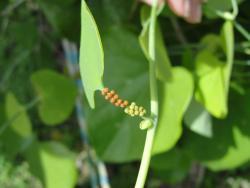
But what if you find a caterpillar? They are very, very similar, and hard to tell when they're very small. The best thing to do would be to keep feeding it whatever you found it on. Pipevine Swallowtails die very fast on tropical pipevines; I've never found one on a tropical pipevine. But in case you want to see the difference, here we go! Both have tubercles (those things that everyone calls antenna in the front) but the Pipevine ST has way longer ones. Also, the Pipevine ST caterpillars tend to be darker in color. Polydamas often get striping or a reddish hue when exposed to UV rays and will lighten as they get bigger. But the tubercles are generally the easiest way to tell. Okay, this isn't the best picture I ever took, but have you ever tried to get two caterpillars to pose? On the left is the Pipevine ST and on the right is the Polydamas.

Here's a look at a much younger Pipevine caterpillar. You can still see how long the front tubercles are compared to the body. Also, the Pipevine cats don't get as thick as the Polydamas.

For comparison, here's a bunch of Polydamas at about the same size. Both species are communal when they're young, but go solo by the time they're almost grown. My mom insists they're "snuggling" and doesn't listen to me when I tell her I think it's a defense mechanism.

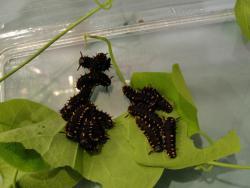
If you still can't tell, tag me in a post or send a Tree Mail and I will try to help! Now, after all this egg and caterpillar talk, some of you are probably thinking, "But what do the butterflies look like, Melanie?" After all, that's the point, right? Well, let's start with some Pipevine Swallowtails. You can actually tell the sexes apart because the males have a super, shimmery blue color on their lower wings (top side). Many, many butterflies also have blue on the bottom of their lower wings to mimic this foul-tasting butterfly. Females don't have as much (or sometimes no) blue. Also, the female is the one that lays the eggs.

Let's start with some female Pipevine Swallowtails. Notice the dull black with white spots. That's only on the top side of their wings, though. Both sexes still have shimmery blue on the underside as you can see in the picture where she's laying eggs (on my tropical pipevine, by the way).

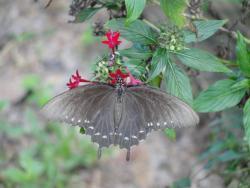

Now, here's some Pipevine males. You don't always see the blue because the light has to hit it in the right way. Butterflies have different ways of making color - some are straight up pigments, some refract or reflect light. There's a lot of research going on in this area right now. But that blue flash is a warning that they taste bad and like I said, many butterflies mimic this. Oh, and don't worry about the guy missing part of his wing. Better to lose part of a wing than your life!
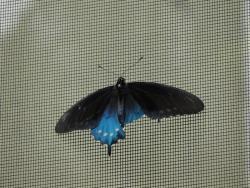

On to the Polydamas! Also known as the "Gold Rim Swallowtail" or the "Tailless Swallowtail". The first name is obvious, but the tailless thing comes from the fact that even though they are a member of the Swallowtail family, Polydamas don't actually have tails. Those tails are also a defense mechanism and are designed to fool birds into going for them instead of the head. Maybe Polydamas taste bad enough they're like, "We don't need no stinkin' tails!" Also, it's very hard to get a shot of them with their wings open so I'm really lucky to get that one picture of it on the plumbago.
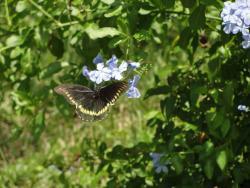
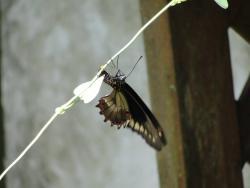
I want to yell "Push" when I see this picture.


So now that we're all educated, I expect to see some caterpillars and butterflies on this thread! Or the butterfly thread. Or both. Spread the love around, you know.
